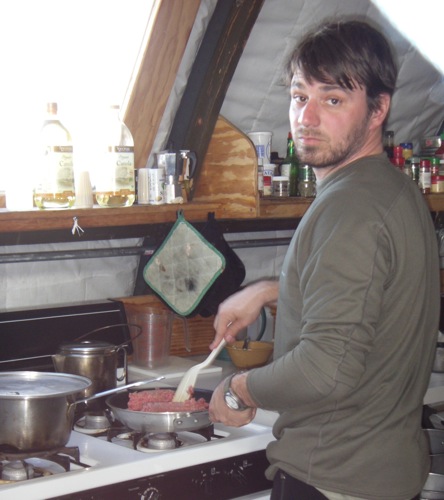Let me give you a little tour of my Lake Fryxell home.
 All are semi-permanent to reduce the camp's impact on the environment.
All are semi-permanent to reduce the camp's impact on the environment.
There are six semi-permanent structures at Lake Fryxell; a power shack, four lab buildings, and a Jamesway. The buildings are considered semi-permanent, because, if necessary, they can be disassembled and removed from the shores of Lake Fryxell. This is one way in which people in Antarctica try to keep the footprint of their camp as small as possible to reduce the impact on the land. The power shack contains two backup generators and other various bits and pieces of the Lake Fryxell power system. Most of the time there is no need for people to tap into the generators, instead our power comes from two sustainable sources; a solar panel and a wind generator.
 One of our two sustainable power sources at Lake Fryxell.
One of our two sustainable power sources at Lake Fryxell.
 The other sustainable power source- when the wind blows it makes a wonderful sound!
The other sustainable power source- when the wind blows it makes a wonderful sound!
Each of the four lab buildings has a different purpose- one is where we conduct experiments with radioactive materials, one with electronic equipment, one for experiments with chemicals, and a general lab.
 One of four lab buildings at Lake Fryxell
One of four lab buildings at Lake Fryxell
 Set-up and ready to test the water samples.
Set-up and ready to test the water samples.
As we are in Antarctica, we always are mindful of our survival, so the Lake Fryxell Camp has a Survival Cache box that contains the necessary tools and equipment for five people to survive for a number of days. Thankfully, the Survival Cache at Lake Fryxell is most often opened only to resupply or update the supplies, not because of an emergency.
 A survival cache at Lake Fryxell with emergency supplies.
A survival cache at Lake Fryxell with emergency supplies.
The bathroom at Lake Fryxell is so much better than I expected. Before I came out to the Camp I was issued a "Pee" Bottle that I thought was all I had to use while out at camp. Instead, we have a beautiful bathroom, but no plumbing. I will share more about how we deal with waste in Antarctica in a later journal...
 I'll save the view from inside for another journal...
I'll save the view from inside for another journal...
The Jamesway, which is pictured in the December 4 journal, is our kitchen/office/living room. It is in the Jamesway that everyone at the Lake Fryxell Camp gathers for meals, to discuss the science procedures and plans, to play games, watch movies, or talk to family and friends over the phone or the Internet. The kitchen is a full kitchen, with a stove, oven, fridge, and all the supplies necessary to make some fantastic meals. Tonight, Heidi and Mike made the most delicious enchiladas for the DOM team. Thanks Mike and Heidi!
 Christine and Mike inside the Jamesway- our kitchen and living room.
Christine and Mike inside the Jamesway- our kitchen and living room.
 Mike (and Heidi) preparing a dinner of enchiladas!
Mike (and Heidi) preparing a dinner of enchiladas!
Our "bedrooms" are tents located behind the Lake Fryxell buildings. There are two types of tents- Scott tents, and Mountain tents. The Scott tents were first used in Antarctica by the Robert F. Scott expeditions in the early 1900s. The tents are heavy, but very easy to set-up, can withstand very high winds, and hold up to six people if necessary. The Mountain tents have a lower profile, and are common camping tents in the States. They are much lighter, but in high winds they have a tendency to blow away- even with people in them!
 The other type of tent available at Lake Fryxell. This style of tent was first used by R.F. Scott in his Antarctic Expeditions in the early 1900s.
The other type of tent available at Lake Fryxell. This style of tent was first used by R.F. Scott in his Antarctic Expeditions in the early 1900s.
 One of two types of tents available as bedrooms at Lake Fryxell.
One of two types of tents available as bedrooms at Lake Fryxell.
I am staying in a Mountain tent at Lake Fryxell. It is large enough for my sleeping bag and pads, with plenty of room left over for my clothing, packs, and other stuff. I have a lovely view of the rest of the camp from my front door, too. At night, I fall asleep to the wind blowing through the wind generator. How lovely.
 Inside my tent- cozy, huh?!?!
Inside my tent- cozy, huh?!?!
